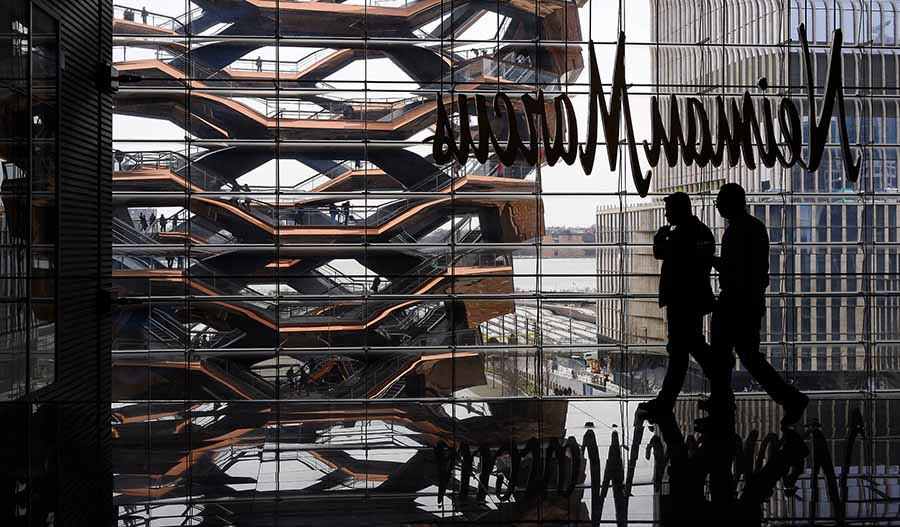S&P Global Ratings rated a ‘CCC+’ issuer credit rating on Neiman Marcus, with a negative outlook. S&P said the luxury chain emerged from bankruptcy and lowered its funded debt, but faces a challenging path to recovery from the ongoing secular pressures that the COVID-19 pandemic has amplified.
S&P said that at the same time, it also assigned a ‘CCC+ issue-level rating to the $750 million senior secured exit financing facilities (including approximately $699.2 million of term loan and $50.8 million of notes) and a ‘3’ recovery rating. The ‘3’ recovery rating indicates its expectation for meaningful (50 percent to 70 percent; rounded estimate 55 percent) recovery in the event of a payment default.
The negative outlook reflects S&P’s expectation that Neiman Marcus’ performance will remain pressured through fiscal 2021 (ending August 2021) with significant uncertainty surrounding the pace of sales and EBITDA recovery. S&P also said it expects sustained high leverage and weak cash flows through fiscal 2022.
S&P said in its analysis, “The COVID-19 pandemic has significantly depressed Neiman Marcus’ performance and the pace of recovery remains highly uncertain, adding to challenges from ongoing secular shifts in consumer spending habits that have pressured the department store industry.
“We currently forecast revenues at Neiman Marcus will continue declining in the mid- to high-single-digit range through fiscal 2021, following about 20 percent declines in fiscal 2020. Temporary stores closures affected fiscal 2020 sales the impact of permanent store closures of select Neiman Marcus full line stores and Last Call locations will affect 2021 sales. We believe the company will struggle to drive substantial in-store traffic over the next 12 months given consumer concerns surrounding health and safety and ongoing efforts to social distance. Though the company has meaningful online presence, which we expect to perform much better than in-store revenues, it only represents a third of total sales and will not make up for sales lost at brick-and-mortar locations. In addition, we expect the greatly weakened macroeconomic environment will add more pressure to high-end discretionary purchases, including luxury clothing and accessories. In our view, we believe the U.S. luxury market could remain weak even after pandemic subsides as consumers shift spending toward other categories.
“Furthermore, the pace of recovery is highly impacted by the potential path of the pandemic through the holiday season and into calendar 2021. To the extent a second wave of cases occurs, we believe there could be heightened social distancing and a second round of temporary store closures across the retail industry, which we expect would further slow recovery.
“We believe leverage wil remain inflated through fiscal 2021 and decline to between 6x and 7x in fiscal 2022 as sales and EBITDA recover but remain well below fiscal 2019 levels.
“With significant revenue decline leading to cost deleveraging, as well as additional expenses related to reorganization, we forecast S&P Global Ratings’ adjusted EBITDA will be flat to slightly positive in fiscal 2021. This results in inflated leverage for the next 12 months, which declines in 2022 to the 6x-to- 7x range. Anticipated deleveraging results from sales growth both in-store and online, and EBITDA margins expand on leveraging of fixed costs and reduction in expenses related to management efforts to improve efficiency and profitability.
“Neiman Marcus successfully reduced funded debt by roughly $4 billion through bankruptcy. Post-emergence, we forecast the company will maintain a high level of draw on its revolver (more than $300 million for the next 24 months), limiting financial flexibility and liquidity. We don’t expect cash flows to be sufficient to materially reduce revolver borrowings until fiscal 2023, so there remains a risk that cash burn could accelerate beyond our base-case expectations if unfavorable market conditions or weaker consumer spending on luxury goods have a negative impact on performance. This would lead to incremental draw on the revolver, pressuring liquidity and reducing flexibility to manage working capital through seasonal peaks. As a result, we believe Neiman Marcus is currently dependent on favorable market conditions to meet its financial commitments and generate sufficient cash to maintain operations, contributing to our view that the capital structure is currently unsustainable.
“We believe the ongoing secular changes in the department store sector will persist and anticipate consumers will continue shifting purchases online, drawn by the convenience, selection, and price transparency.
“Although Neiman is a recognized brand with a large omnichannel presence, we believe its market position has become increasingly vulnerable given the challenges facing it in the narrow luxury department store sector. We also think the operating environment for department stores and retail apparel companies will remain difficult because they will face top-line and margin pressure from competitive threats even as the department stores work to address these challenges with investments in their merchandise and online presence. Furthermore, we see extra risks in the luxury retail segment, including longer product lead times that reduce working capital flexibility.
“The negative outlook on Neiman Marcus reflects our view that the capital structure is unsustainable based on our expectation for weak performance over the next 12 months, with an uncertain path for recovery. We believe the company is currently vulnerable and dependent on favorable developments in its business and the economy to meet its financial commitments.”
Photo courtesy Neiman Marcus
















